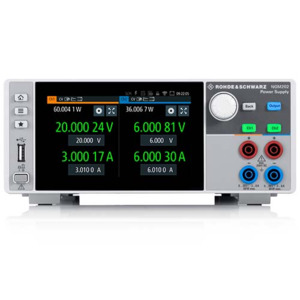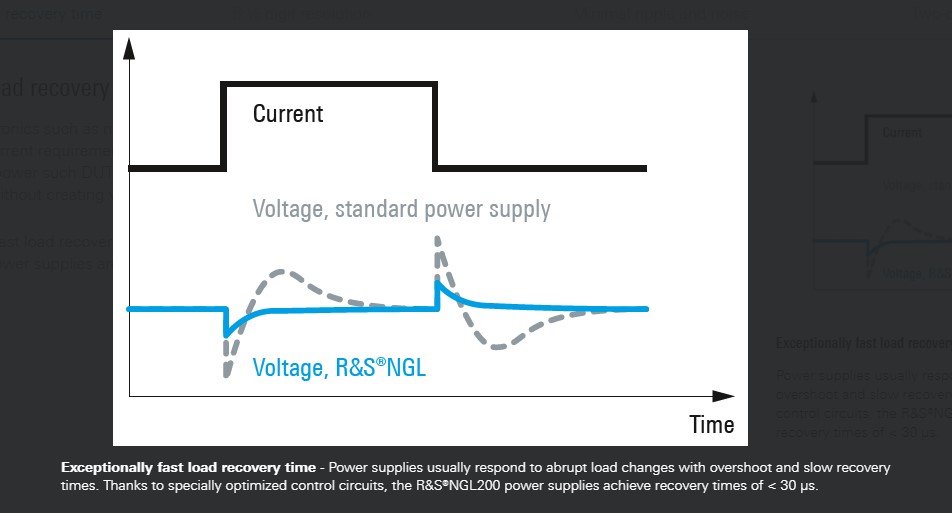
- Description
- Attributes
- Documents
- Max. output power: 120 W
- Voltage per channel: 0 V to 20 V
- Max. current per channel: 6 A
- Load recovery time: < 30 µs
- Ripple and noise: < 500 µVRMS / < 1 mARMS
- Extremely fast logging function (of up to 500 ksample/s)
- Higher accuracy
- Digital voltmeter functionality
- Battery simulation functionality
- Very high resolution of 800 × 480 pixels, the display sets new standards
- Connectors also on the rear panel for system integration
- USB and LAN (Ethernet) interfaces (Standard)
- Wireless LAN and IEEE-488 (GPIB) (Optional)
The R&S®NGM200 Power Supply series is perfect for challenging applications requiring high accuracy and fast load recovery time. The two-quadrant architecture allows them to function both as a source and as a sink to simulate batteries and loads.
Their short recovery times enable them to handle fast load changes that occur, for example, when mobile communications devices switch from sleep mode to transmit mode.
They are all suited for all kind of applications where precise source and sink functionality is needed, especially whenever you need a wide range from a few μA to amps.
Features include:
Fast load regulation
Consumer electronics such as mobile phones and IoT devices require very little power in sleep mode. However, the current increases abruptly as soon as the device switches to transmit mode.
A power supply used to power such DUTs must be capable of handling load changes from a few μA to amps range without creating voltage drops or overshoots.
The R&S®NGM power supplies have a circuit design that allows the user to determine how the power supply regulates load changes.
The "Fast" default setting is optimized for speed, achieving recovery times of <30μs. Deactivating "Fast" slightly increases the recovery time focusing on preventing overshoots under special load conditions.

Minimum residual ripple and low noise
Advanced electronic circuitry is often very complex and sensitive to interference on the supply lines. In order to supply interference-free voltage to such sensitive DUTs, the power supplies must provide extremely stable output voltages and currents.
Ripple and noise need to be avoided. The R&S®NGM power supplies have linear regulation and are ideal for sensitive DUTs.
Two quadrants: operates as source and sink
The two-quadrant architecture of the R&S®NGM power supplies allows them to function both as a source and a sink and act as batteries or loads.
The power supply automatically switches from source mode to sink mode. As soon as the externally applied voltage exceeds the set nominal voltage, current flows into the power supply. This is indicated by a negative current reading.
High-resolution touchscreen
The large capacitive touchscreen is the central operating element for R&S®NGM power supplies. Lightly tapping a numerical value will display a virtual keyboard to input the desired value.
Alternatively, the voltage, current and limits for the various protection functions can be set using the rotary knob. Functions that are less frequently used can be accessed and operated via menus.
With its very high resolution of 800 × 480 pixels, the display sets new standards for power supplies. The large high-resolution display makes it easy to read the voltage and current values, even at great distances.
Voltage, current and power measurement values are shown with up to 6½ digit resolution. A variety of additional information, such as power values or statistics, can also be displayed. Icons clearly show the status of the set protection or special functions.
Ideal for use in labs and test systems
The R&S®NGM power supplies are the right choice for challenging applications. They are used in R&D labs and integrated into production test systems.
The power supplies can be installed in 19" racks using the R&S®HZN96 rack adapter. Connectors on the rear panel and a compact design are important criteria for use in test systems. For use in test systems, the R&S®NGM power supply series can be remotely controlled. The following interfaces are available:
- USB and LAN (Ethernet) interfaces (Standard)
- Wireless LAN (R&S®NGL-K102 / R&S®NGM-K102 options)
- IEEE-488 (GPIB) interface (R&S®NGL-B105 / R&S®NGM-B105 options)
Digital inputs and outputs are optionally available (R&S®NGL/NGM-K103 options). They can be used as trigger/inhibit inputs and control/fault outputs. One more connection is configurable.
High-speed data acquisition (FastLog functionality)
R&S®NGM200 offers a high-speed FastLog functionality to capture and to store voltage and current measurement results.
Data can be stored on an external USB storage device or can be transferred to an external PC via USB or LAN. With an acquisition rate of up to 500 ksample/s, voltage and current results are available every 2 μs.
Using the two-channel R&S®NGM202, the data acquisition can run on both channels in parallel.
With this high-speed acquisition, even spikes in the microsecond range, which cannot be detected with slower instruments, can be detected in min./max. values.
Higher accuracy
Modern power supplies can measure the voltage/current applied to the DUT (readback functionality). The R&S®NGM200 power supplies provide two voltage measurement ranges and four ranges to measure current and therefore achieve a higher accuracy and better resolutions.
Digital voltmeter functionality
Like other power supplies, the R&S®NGM200 instruments measure the voltage supplied to the DUT. In addition, the R&S®NGM-K104 option activates a port that allows the internal digital voltmeter to be connected to any other point in the customer’s circuitry.
In many cases, an additional digital multimeter is not necessary.
Battery simulation
Real batteries show different characteristics depending on the type of battery and its charging condition. Capacity, open circuit voltage (Voc) and equivalent series resistance (ESR) are important battery characteristics that depend on its state of charge (SoC).
The optional R&S®NGM-K106 functionality allows users to simulate the behavior of batteries under different charging conditions, e.g. when powering a DUT.
To define a battery model, the data of the battery can be entered easily using the integrated battery model editor. Data sets for the common battery types Pb, LiIon, NiCd and NiMH are available as preconfigured files.
In particular, when battery-operated devices have to be optimized for lifecycle, the discharging behavior of the used battery type needs to be considered. The battery simulator function of the R&S®NGM200 makes it possible to simulate the real battery output performance. Testing can be based on a selected battery model, while battery capacity, SoC and Voc can be set to any state to test the device under specific circumstances.
The charging behavior of a battery can also be simulated. This is particularly important when designing battery chargers. In this application, the R&S®NGM200 power supply is used in sink mode.
